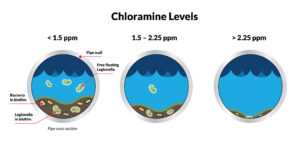Chloramines for Legionella and Waterborne Pathogen Control
What are chloramines and how do they react with Legionella?
For support regarding our monochloramine systems or other pathogen control products and services, please contact our friendly team.
Hours: 24 hours per day, 7 days per week
Tel: 888-416-8626
Email: info@legionellacontrolsystems.com
Contact us for a quote on your monochloramine system:
Tel: +1 888-416-8626
Email: info@legionellacontrolsystems.com
 Monochloramine is a chemical injected into water systems as a secondary disinfectant to kill legionella and other pathogens in piping systems. Chloramines are commonly formed when ammonium is added to chlorine to treat water. Monochloramines are the most common form of chloramines and are often used in the water treatment process. They are generally used in conjunction with a primary disinfectant such as chlorine. Since monochloramine has a longer kill time it is not practical in most systems to use it as a primary disinfectant unless it is used in combination with other chemicals.
Monochloramine is a chemical injected into water systems as a secondary disinfectant to kill legionella and other pathogens in piping systems. Chloramines are commonly formed when ammonium is added to chlorine to treat water. Monochloramines are the most common form of chloramines and are often used in the water treatment process. They are generally used in conjunction with a primary disinfectant such as chlorine. Since monochloramine has a longer kill time it is not practical in most systems to use it as a primary disinfectant unless it is used in combination with other chemicals.
Chloramines have shown that they are somewhat effective in penetrating biofilm. Chlorine Dioxide, Mixed Oxidant Solution (MOS – MIOX) and Advanced Oxidation Process (AOP) are other options removing biofilm and preventing it from forming.
How do chloramines work to control Legionella?
Chloramines can kill Legionella and other bacteria by penetrating the cell wall then blocking the metabolism of the organism. Monochloramine reacts with amino acids in the bacterial DNA to achieve disinfection. During deactivation of microorganisms, chloramines destroy the shell which protects a virus. At pH values above 7, monochloramines are the most abundant chloramines.
Monochloramines vs chlorine as a secondary disinfectant to kill Legionella
Monochloramine is much less volatile than chlorine and this allows it to remain effective in water for a longer time, which is beneficial to control Legionella. However, the disinfection process is slower and less aggressive than regular chlorine. Chloramines like chlorine dioxide are less likely to interact with organic matter. This means that they will produce less DBP’s (disinfection by-products) which have been associated with kidney and liver problems. Monochloramines are also harder to filter out of water. Chlorine can be removed with a standard activated carbon filter while chloramines would need a more advanced catalytic carbon filter.
Sizing your Legionella control chloramine system
Sizing of a Legionella control chloramine system is based on several variables. These include water quality, gallons used daily, peak water usage and desired residual. Use our sizing calculator today.
Industrial Water System Service
Ready to buy a monochloramine Legionella controls system, or just need more information? Contact Legionella Control Systems at info@legionellacontrolsystems.com or 888-416-8626 for design, service and sales of industrial water systems in Indiana, the Midwest and throughout the U.S. Our experienced engineers are ready to help.
Contact Legionella Control Systems for CDC Legionella risk assessment and Legionella testing.







